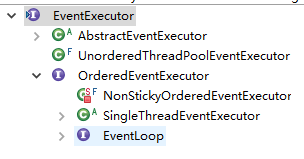在上一篇中的简单代码中开头的两行代码是
1 EventLoopGroup boss = new NioEventLoopGroup(1); 2 EventLoopGroup worker = new NioEventLoopGroup();
服务端应用要创建首先要创建两个EventLoopGroup ,为什么是两个EventLoopGroup ,这就涉及netty的核心设计思想——主从Reactor模型。这里不展开说,内容比较多,可以自行学习。每个EventLoopGroup 可以包含一个或多个EventLoop,每一个EventLoop简单来说的就是一个死循环的线程,这个线程循环监听一个通道的所有事件,这个模式下面其他流程中也会反复提到。下面开始追代码。
说明一下,上面的两个构造函数一个有参数一个无参数,无参数的通过获取本机cpu的核数(注意是核数不是个数,例如我的电脑4个cpu,每个cpu都是双核的,所以无参的时候应该创建8个EventLoop)来决定创建线程的个数,有参数就是指定在这个EventLoopGroup 中创建具体个数的EventLoop。
- 一步一步追NioEventLoopGroup的构造函数可以发现,代码中,如果指定nThreads 就是用指定的,例如第一个构造函数中那样,不然就是用DEFAULT_EVENT_LOOP_THREADS,DEFAULT_EVENT_LOOP_THREADS在本类的静态代码块中初始化
protected MultithreadEventLoopGroup(int nThreads, ThreadFactory threadFactory, Object... args) { super(nThreads == 0 ? DEFAULT_EVENT_LOOP_THREADS : nThreads, threadFactory, args); }
static { DEFAULT_EVENT_LOOP_THREADS = Math.max(1, SystemPropertyUtil.getInt( "io.netty.eventLoopThreads", Runtime.getRuntime().availableProcessors() * 2)); //获取本机cup核数 if (logger.isDebugEnabled()) { logger.debug("-Dio.netty.eventLoopThreads: {}", DEFAULT_EVENT_LOOP_THREADS); } }
- 再追一步会看到,DefaultEventExecutorChooserFactory.INSTANCE使用默认的选择器工厂,在下一步中会提到,这个东东决定了在EventLoopGroup 执行next()时候,也就是切换到下一个EventLoop的时候,是以怎样的算法找到下一个EventLoop,默认就是按照EventLoop数组中的顺序查找下一个的
protected MultithreadEventExecutorGroup(int nThreads, Executor executor, Object... args) { this(nThreads, executor, DefaultEventExecutorChooserFactory.INSTANCE, args); }
- 再追下一步构造函数,真正干活的来了,注意!!!在主要代码会有注释
protected MultithreadEventExecutorGroup(int nThreads, Executor executor, EventExecutorChooserFactory chooserFactory, Object... args) { if (nThreads <= 0) { throw new IllegalArgumentException(String.format("nThreads: %d (expected: > 0)", nThreads)); } if (executor == null) { executor = new ThreadPerTaskExecutor(newDefaultThreadFactory()); //创建默认的线程执行器 } children = new EventExecutor[nThreads]; //创建保存EventLoop的数组 for (int i = 0; i < nThreads; i ++) { boolean success = false; try { children[i] = newChild(executor, args); //循环填充数组,在这里实例化每一个EventLoop success = true; } catch (Exception e) { // TODO: Think about if this is a good exception type throw new IllegalStateException("failed to create a child event loop", e); } finally { if (!success) { for (int j = 0; j < i; j ++) { children[j].shutdownGracefully(); } for (int j = 0; j < i; j ++) { EventExecutor e = children[j]; try { while (!e.isTerminated()) { e.awaitTermination(Integer.MAX_VALUE, TimeUnit.SECONDS); } } catch (InterruptedException interrupted) { // Let the caller handle the interruption. Thread.currentThread().interrupt(); break; } } } } } chooser = chooserFactory.newChooser(children); //将创建好的EventLoop数组注册到选择器工厂 final FutureListener<Object> terminationListener = new FutureListener<Object>() { @Override public void operationComplete(Future<Object> future) throws Exception { if (terminatedChildren.incrementAndGet() == children.length) { terminationFuture.setSuccess(null); } } }; for (EventExecutor e: children) { e.terminationFuture().addListener(terminationListener); } Set<EventExecutor> childrenSet = new LinkedHashSet<EventExecutor>(children.length); Collections.addAll(childrenSet, children); readonlyChildren = Collections.unmodifiableSet(childrenSet); }

EventExecutor是一个接口,是EventLoop接口的子接口,当children[i] = newChild(executor, args)执行时,实际上执行的是NioEventLoopGroup中重写的,可以发现创建的NioEventLoop的实例,而NioEventLoop间接实现了EventLoop@Override protected EventLoop newChild(Executor executor, Object... args) throws Exception { return new NioEventLoop(this, executor, (SelectorProvider) args[0], ((SelectStrategyFactory) args[1]).newSelectStrategy(), (RejectedExecutionHandler) args[2]); }
至此EventLoopGroup以及包含的多个EventLoop创建完成,这里只是在EventLoopGroup中创建了多个NioEventLoop,NioEventLoop并没有run起来,需要在注册通道后才能run起来监控通道的事件和执行task。后面章节还会介绍NioEventLoop类中的在其他方法。ok,这个部分就到这。